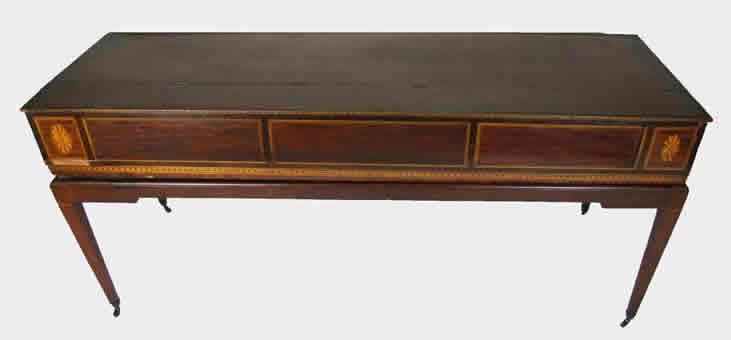John Byrne Pianoforte-maker, Dublin: Timeline
(added 27 February 2017; updated 4 March 2017)
Summary A square piano case advertised by George Kidner Auctioneers & Valuers of Lymington, Hampshire for sale by auction in March 2017 bears a striking resemblance to the exterior of extant instruments with additional keys made by the house of Southwell in Dublin in the second half of the 1790s.
Sadly nothing now remains of the piano forte action in this conversion. Only the nameboard survives, which clearly shows the makers name as 'Byrne' and with one of the two fretwork 'sonovents' still intact.
It appears likely that this instrument was copied from Southwell's 'pianoforte with additional keys', (patented in London in 1794). However, as may be noted in the above image, the design of the fretwork sonovent is different from that seen on extant Southwell instruments and the decoration on the nameboard is somewhat simpler in style. So who was Byrne? Little has been known of his life and work to date; however, the author has recently identified a number of contemporary newspaper advertisements and reports relating to his activities as a piano forte maker in Dublin between the years 1795 and 1824. These include firm evidence that in the year 1814 John Byrne of Ship-street, Dublin was taken to court by Clementi and Co. of London for making and selling piano fortes fraudulently badged using their name. And in 1820 a John Byrne, also of Ship-street, was reported to be in the employment of Mr. Southwell, piano forte maker of Marlborough-street, Dublin, thus providing an intriguing later link with the house of Southwell. [It should be noted that the Mr Southwell mentioned in this latter report must refer to John Southwell, son of William Southwell Senior, who is listed in The Commercial Directory of Scotland, Ireland and the four most Northern Counties of England in 1820-21 and 22 in business at 34, Marlborough-steet Dublin where his occupation is given as 'music dealer, pianoforte maker and pianoforte dealer.] More detailed information about these finding is presented in the timeline below. |
|||||
| Timeline | |||||
| 1795 | An advertisement placed by Bell [a Dublin auction house] in August 1795 includes 'a Piano Forte, made by Byrne' (Saunder's Newsletter, Dublin, 19 August 1795) |
||||
| 1802 | Byrne himself placed two advertisements in this year that not only provide information on his address at that time but confirm that he was indeed making Piano Fortes with additional keys. An extract is given below.
|
||||
| 1805 | From an advertisement placed in this year, we learn that Byrne's forename began with 'J' - see extract below:
|
||||
| 1807 | In 1807 J. Byrne placed an advertisement announcing his change of address, which suggests that by this time his business was growing and attracting a wider clientele.
|
||||
| 1814 | In July of this year a newspaper notice placed by Clementi and Co., states that they were commencing court proceedings against three Dublin firms, including John Byrne of Ship-street, whom they accused of making and/or selling instruments fraudulently badged using their name. The existence of this advertisement was first identified by I M Hogan (Ita Margaret Hogan 1966. Anglo Irish Music 1780 - 1830. Cork University Press, 107). However Hogan did not give the full text, now located by the author, and this is quoted in full below:
[Author's note: It is interesting to note that Byrne's advertisements in earlier years suggest that he was selling pianos badged using his own name, even though probably copying Southwell's design. Additional evidence to support this is provided by the surviving name board on a square piano case in George Kidner's auction sale of 2 March 2017, which clearly bears the name Byrne. Presumably it proved tempting to badge instruments fraudulently using the names of established London makers, notably Clementi, in order to obtain a higher sale price.] According to I M Hogan (1966) John Byrne of Ship-street, pianoforte maker, appeared in Dublin trade directories from 1814 through to 1824. |
||||
| 1820 | On 25 September 1820 an intriguing report appeared in a Belfast newspaper relating to the conduct of the Princess of Wales (by then Queen Caroline, although she was never crowned) on the ship Leviathon, based on the first hand testimony of one John Byrne who had been employed on board as a cabin-joiner. At the time this report was published Byrne was said to be in the employment of Mr Southwell, piano forte maker, Marlborough-street [Dublin]. The report provides evidence of a firm connection between John Byrne and the house of Southwell - as well as making fascinating reading in its own right in the context of the history of the royal family at that time. A transcription of the text is given below:
|
||||
| 1824 | There is an entry John Byrne, piano, at 15 Great Ship-street, Dublin in Piggotts Directory, 1824, the last mention of him located by the author. His date of death presently remains unknown. |






